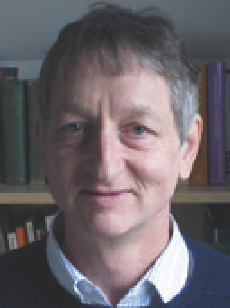Information Technology Reference
In-Depth Information
Imagine a simple three-layer neural network: a layer of input neurons,
connected to a second hidden layer of neurons, which in turn is linked to a
layer of output neurons (
Fig. 13.18
). Each neuron converts its inputs into a sin-
gle output, which it transmits to neurons in the next layer. The conversion
process has two stages. First, each incoming signal is multiplied by the weight
of the connection, and then all these weighted inputs are added together to
give a total weighted input. In the second stage, this combined input is passed
through an activation function, such as the function of
Figure 13.17
, to generate
the output signal for the neuron. To train the network to perform a particular
task, we must set the weights on the connections appropriately. The amount of
weight on a connection determines the strength of the influence between the
two neurons. The network is trained by using patterns of activity for the input
neurons together with the desired pattern of activities for the output neurons.
After assigning the initial weights randomly, say to be between -1.0 to +1.0,
then, by calculating the weighted input signals and outputs of the neurons in
each layer of the network, we can determine the strength of the signals at the
output neurons. For each input pattern, we know what pattern we want to
see at the output layer, so we can see how closely our model output matches
the desired output. We now have to adjust each of the weights so that the net-
work produces a closer approximation to our desired output. We do this by
first calculating the error, defined as the square of the difference between the
actual and desired outputs. We want to change the weight of each connection
to reduce this error by an amount that is proportional to the rate at which the
error changes as the weight is altered. We first make such changes for all the
neurons in the output layer. We then repeat the calculation to find the sensitiv-
ity to the weights connecting each layer, working backward layer by layer from
the output to the input. The idea is that each hidden node contributes some
fraction of the error at each of the output nodes to which it is connected. This
type of network is known as a
feed-forward
network because the signals between
the neurons travel in only one direction, from the input nodes, through the
hidden nodes, to the output nodes. The learning algorithm to train the neu-
ral network is called
back propagation
because the error at the output layer is
propagated
- that is, passed along - backward through the hidden layer of the
network (see
Fig. 13.18
).
In the 1990s, researchers found it hard to train neural networks with
more than one hidden layer and two layers of weights. The problem was that
the weights on any extra layers could not be adapted to produce significant
improvements in learning. However, within the last few years, Geoffrey Hinton
and colleagues from the University of Toronto, and researchers Li Deng and
Dong Yu from Microsoft Research have shown that much deeper layered net-
works can not only be trained efficiently but can also deliver significantly
improved learning outcomes. This
deep learning
approach is currently causing
great excitement in the machine-learning community and is already leading to
new commercial applications.
Hidden layer
Input layer
Output layer
X
1
Y
1
X
2
Y
2
X
3
Weights
Fig. 13.18. An example of a three-layer
ANN, with all connections between
layers. The output of the neural network
is specified by the connectivity of the
neurons, the weights on the connec-
tions, the input signals, and the thresh-
old function.
B.13.9. Geoffrey Hinton is a com-
puter scientist based in Toronto
who was one of the first computer
scientists to show how to make com-
puters “learn” more like a human
brain. He has recently participated
in exciting advances using so-called
deep neural networks. His start-up
company on such approaches to
computer learning and recognition
problems was bought by Google
in 2013. Hinton is the great-great-
grandson of logician George Boole.
Photo by Emma Hinton












































Search WWH ::

Custom Search